

Home Page - Osprey Main Page - Migration Page - Birds of Prey
Migration 2011
|
Jump to the 2012 Migration pages Scroll down for links to maps, updates on old birds, and bios for this year's class.
Spring migration (map below) was uneventful--a welcome relief
after last fall! Our boys were late starters, but the adults (Sr. Bones, North
Fork Bob, and Sanford) all returned to their breeding territories. Buck, our 2-yr
old had been bouncing around between North Carolina and New Hampshire (!) since his
arrival in North Carolina back in April. He finally (Aug 13th) made it back to
his natal area. Subscribe to the email "New Maps Alert" list. Join the new Osprey Migration Google Group forum. Visit the Westport River Osprey website. 2011 Osprey cams and links:Really amazing videos of Ospreys hunting. Why Ospreys hate Great-horned Owls. What one young Osprey thinks of the nestcam that's gives him no privacy! (Don't miss this one!) ------------------------------ Spring Migration 2011 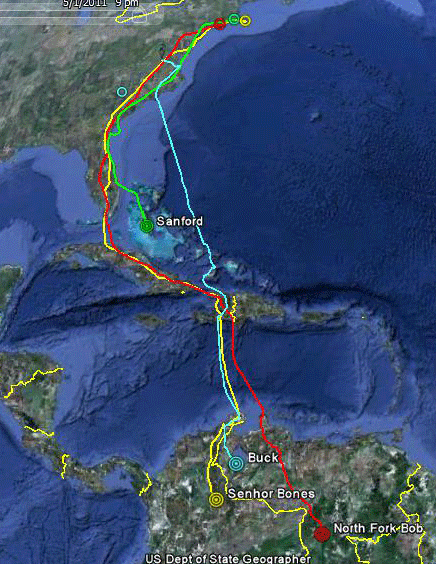 |
Fall Migration
2011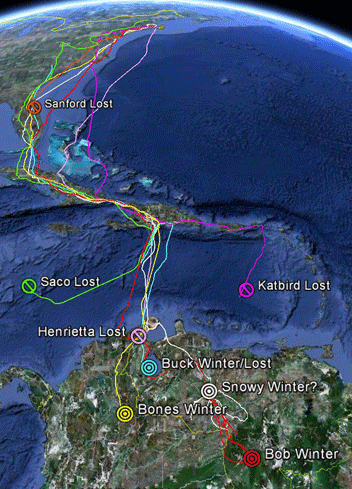 27 Dec 2011. The fall turned into another nightmare migration season. We lost 4 of our 8 migrating birds in about 10 days and another some weeks later. All the surviving males are back on their wintering waters, and our lone juvenile, Snowy, is temporarily at least, settled down in northern Venezuela. We expect him to explore some more over the course of the winter. Katbird, an adult male from Martha's Vineyard, flew out over the Caribbean into some nasty weather. We have lost his signal, so we presume he didn't make the crossing. Saco (NH youngster) arrived in Cuba and worked her way to Haiti. She took off over the Caribbean and was also lost at sea. Five birds made it safely across the Caribbean to Colombia or Venezuela. These were Henrietta, a juvenile tagged at our old faithful nest on Lake Tashmoo on Martha's Vineyard, Sr. Bones, an adult male from Nantucket, and North-Fork Bob from Long Island, Buck, returning for his second stay in Venezuela, and Snowy, a juvenile from Martha's Vineyard. At the start of her migration, Henrietta took on the Atlantic and crossed our corner of it in less than two full days. After crossing the Caribbean, she settled down in Colombia for a couple of weeks and then started moving again. Her transmitter stopped moving and signaling, so she's either dead or dropped her transmitter. Our adult male from Nantucket, Sr. Bones, took the safer, adult route south down the U.S east coast and is now back at his wintering grounds in Colombia. Bob just got to Colombia and moseyed his way back to his wintering waters in Venezuela. Buck (SC sub-adult from '09) started out over the Caribbean twice and retreated both times to the D.R. He finally crossed the Caribbean and got back to his winter home, but either died or last his transmitter a few weeks later. Snowy (MVY bird of the year) settled down for a while in the D.R. but is now pushing south through Venezuela. Finally, Sanford, our adult male from the Westport River got the "last one out, turn off the lights" award for this year. He left last year on Oct 2nd. This year he took off on the 12th, so he was 10 days behind schedule. About 10 days later he pretty much dropped out of the sky just east of Orlando. We've recovered the transmitter from his body. Very mysterious to lose a bird like this. Strange as it sounds, he may have had a heart attack. |
Use these links to go straight to a bird's maps or bios. Names in hot pink are newly updated (data through 6 March 2012). (More details on the project below).
| Belle | '10 Juvenile - Martha's Vineyard/MA | Bio - Map - Way down in Brazil. Updated 5 March 2012. |
| Thatch | '10 Juvenile - Cape Henlopen/DE | Bio - Map - Deep in the Brazilian Amazon. Updated 5 March 2012. |
| Snowy | '11 Young male tagged post fledging on the Chappaquiddick shores of Katama Bay. | Bio - Map - One of two healthy young at a nest that has not been very productive over the years. He's down in Venezuela, temporarily(?) settled down: Updated 6 March 2012. |
| Buck | '09 Juvenile - Great Falls/SC | Bio - '09 Map - '10 Map - '11 Map Just about to cross the Caribbean. Perhaps our most interesting bird to date. Updated 21 Nov 2011 (last map). |
| Sanford | '10 Adult male - West branch Westport River/MA | Bio - Map - Now using Hudson's transmitter. Nest failed. wintered in the Bahamas. Back on the Westport River-did not breed in 2011. Maps show month-by-month comparisons of 2010 and 2011. Updated 25 Oct 2011. (last map). |
| Sr. Bones | '10 Adult male - Nantucket/MA | Bio - Map - Nest failed in 2010. Began migration on 10 Sept. Wintered in Colombia. Now back on his wintering grounds 33 days after leaving Nantucket. Updated 19 Oct 2011. |
| North Fork Bob | '10 Adult male - Mattituck, Long Island/NY. | Bio - Map - Wintered in Amazonian Venezuela. He's now in Venezuela heading towards his winter home. Updated 5 Jan 2012. |
| Tucker | '11 Adult male - Mattituck, Long Island/NY. | Bio - Map - Died when hit by a bus a month after we tagged him on Long Island's North Fork. Updated 21 June 2011.(last map) |
| Katbird | '11 Adult male - Chappaquiddick Island, Martha's Vineyard MA | Bio - Map - Nest failed after satellite transmitter deployment. Signal lost over the Caribbean in some nasty weather Updated 25 Oct 2011. (last map) |
| Saco | '11 Young female tagged prior to fledging at the Ayers Island Reservoir hydroelectric dam. | Bio - Map - One of three young at a nest on the Pemigewasset River in central New Hampshire. Lost crossing the Caribbean. Updated 31 Oct 2011. (last map) |
| Henrietta | '11 Young female tagged at our favorite nest on Lake Tashmoo on Martha's Vineyard's north shore. | Bio - Map - Hatched on May 24th, took her first voluntary flight on July 27th. She made it to Colombia and then was lost. No idea on what happened to her. Updated 15 Oct 2011. (last map) |
Overview of our
Osprey research
This is the 12th year of our satellite
tracking and the 14th year that we have been
following the Osprey population on Martha's
Vineyard. The "we" here includes lots of friends
and colleagues, but most importantly Dick
Jennings. Dick "retired" to Martha's Vineyard
where he is probably busier now than he was when
he was earning a paycheck. He is a naturalist
for the Trustees of Reservations and my
right-hand man in all Vineyard Osprey trapping
and censuses.
At the end of the 2011 trapping season we had trapped
72 Ospreys and satellite tagged 49 of that total
(35 young and 14 adults). Over the 14 years of
our censuses, we've counted over 900 nesting attempts
and watched more than 1,000 young fledge!
Link
to details of our census work (a
couple of years out of date, but the big picture
is there.)
Tagging new birds in 2011
Adults- We tagged only 2 of the
5 adult males we planned on tagging this spring,
"Tucker" in Mattituck on Long Island's North
Fork, and "Katbird" on the shores of Katama
Bay on Martha's Vineyard.
Juveniles- I keep trying to
wrap up the studies of juvenile migration, but
somehow can't quite kick the habit. We
tagged four this year.
As 2011 began, we were down to only six surviving birds--Sr. Bones, Sanford, North Fork Bob (all adult males), Buck (an almost 2-yr old from South Carolina), and Belle and Thatch. Sr. Bones is raising his first young (his nest failed in previous years). Sanford and North Fork Bob did not breed for reasons unknown. Buck bounced around the northeastern states from Virginia to New England until finally getting back to South Carolina more than 80 days and 7,000 miles later (all of these miles were in the states after getting to North Carolina!). Belle and Thatch seem to have settled down in Brazil. They both did quite a bit of exploring in their first six months on the wintering grounds.
Who's Who - Bios of the Class of '11 (newly tagged birds)
Tucker
- This Long Island male was trapped at the
nest where we caught North Fork Bob last year. Last summer we were trying to catch a young
at a nest in Mattituck, on Long Island's North Fork, when an adult male landed
in the nest intent on dining on the fish we had laid out as bait. We didn't know
he was not the adult male at that nest until we looked at his satellite data
three days later.
This year, we set our noose cage over two just-hatched
chicks and an egg. We caught the female in just a few minutes and then Tucker
within another half hour.
Sadly, Tucker was killed when he flew into a bus close
to his home. My colleague Alan Poole spent some time on the North Fork of Long
Island back in the mid-70s. He remembers the stretch of road where Tucker died
as being really dangerous for Ospreys. Almost every year they had a fatality
there. Tucker's mate has been doing the single parent thing successfully and has
at least 1 young still going in the nest.
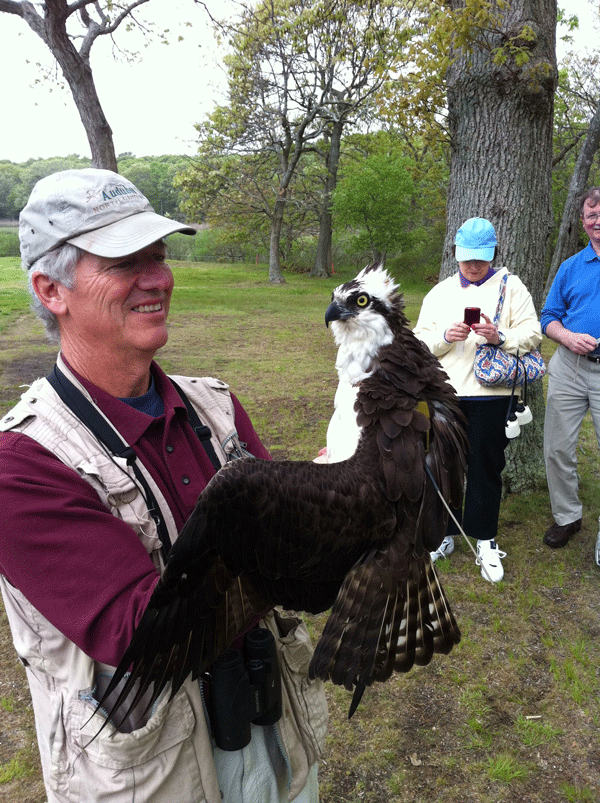 |
Katbird - A male
on Chappaquiddick Island at the east end of Martha's Vineyard.
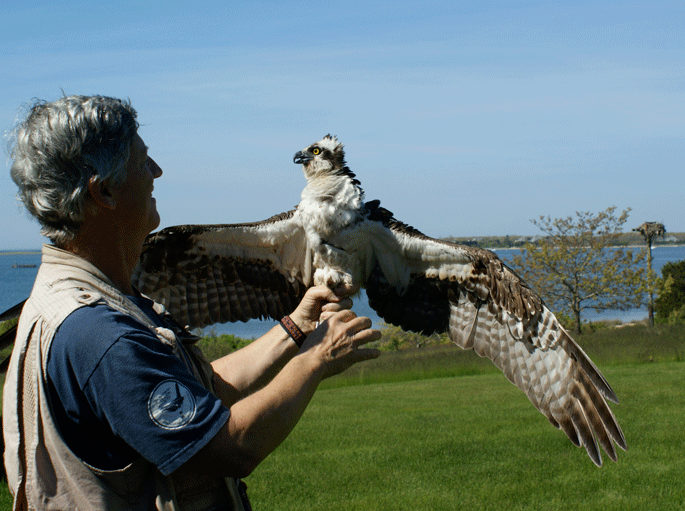
We caught this male at the first nest we tried this year on
the Chappaquiddick shore of Katama Bay on Martha's Vineyard.
Shortly after we arrived at the nest, the male came in with the last half of a
good sized fish. The female took it from him and gorged on it while he sat on
the eggs. After she had finished her meal, we placed the noose cage over the
three eggs in the nest. We caught the male within about 20 minutes.
Sadly, "Katbird" did not respond well to the tagging
and left the nest for 3 days, which resulted in a nest failure. This is the
first time I've experienced or even heard about such a reaction. It was a
sobering reminder that our studies of wildlife is not without impact, and we
must weigh the benefits of our work against the cost to the species we are
studying.
While we did lose a nesting season for this pair, both
adults are fine, and if they both make it through the migration to South America
and back, they should be back at it next spring. One thing we need to keep in
mind is that an Osprey can breed for well over a decade, so one lost brood is
not a major setback.
| The July Trapping Expedition - New Hampshire |
We tagged 2 young at the Ayers Island Hydroelectric Plant on 12 July (and 2 more on Martha's Vineyard on the 15th and 16th-see below).
The easy way to grab Pemi
and Saco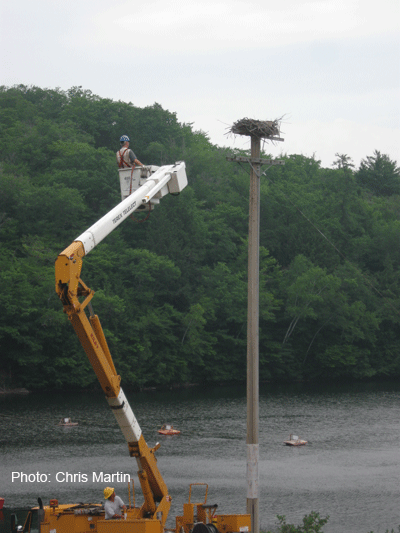 |
Iain MacLeod,
director of the
Squam Lakes Natural Science
Center in New Hampshire's lakes
region (the middle of the state), contacted me
last year about beginning a satellite telemetry
study of New Hampshire's Ospreys. Iain's Osprey
roots run deep--back to his work in his native
Scotland a couple of decades ago, where he
worked with Scotland's Osprey Guru
Roy Dennis
(Roy's website is fascinating). Iain has been on
our side of the pond for many years now. When he learned of our tracking work, he was intrigued and, after I said I'd love to expand our studies to inland-fishing Ospreys, he pulled together funding for some transmitters. An earlier trip to New Hampshire back in May to trap adult males was frustratingly fruitless. We only had 2 nests to work with, and trapping adult males is never a sure thing. When we were unsuccessful at trapping males, we planned to tag 2 young at each of the 2 target nests. Continuing our run of bad luck, one of the two nests blew down in a wild windstorm, so we were left with only one nest to work with. I went back up to New Hampshire on 12 July and tagged two of the three young in the nest at the Ayers Island dam. Links: Watch these birds in their nest on a live stream webcam. More photos of the tagging operation. New Hampshire's Project OspreyTrack website. A video about the project. |
-(small-image).gif) |
Saco, a female named for the Saco River, was the oldest of the three young in the nest. She was pretty calm through the tagging process. [My Brazilian friends will get a chuckle out of this name!] |
-small-image.gif) |
Pemi, named for the Pemigewasset River (I love New England place names), was the second hatched--maybe a day or two younger than his big sister. He was feisty from the start. The arm that Pemi is munching on belongs to Chris Martin, Senior Biologist at New Hampshire Audubon, who was lending a hand (and arm) during the tagging process. |
-and-Saco-(r)-ready-to-back-to-nest-(small).gif) The feisty Pemi (left) and his cool big sister Saco (right) ready to go back to their nest. The hoods keep them calm during the tagging process. |
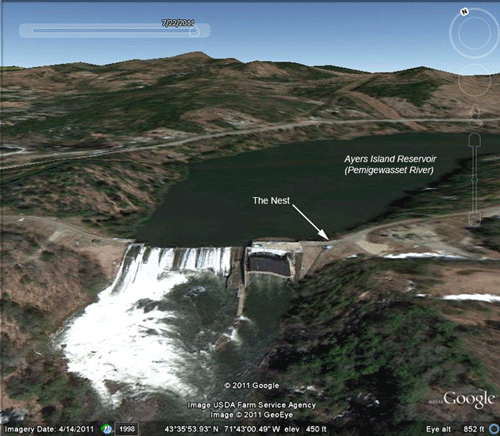 |
July Trapping Expedition -
Martha's Vineyard
Lake Tashmoo -
"Henrietta"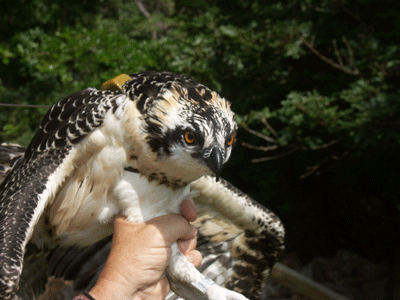 |
15 July - We returned to
our favorite nest for tagging juveniles. We like
it because it's a very productive nest and we
can reach it with our ladder. This is the site
where we tagged our very first youngster, Tasha,
back in 2004. Subsequently, we tagged Meadow
(who went to Lake Superior before migrating to
the D.R.), and Belle, who is now down on the
Amazon. This bird, Henrietta, was one of two in the nest. The elder youngster flew as we put up the ladder. It was obviously ready to go, and I suspect what we saw was not its first flight. Henrietta wasn't quite ready to go but decided that I was scarier than her first flight, so she took off across the marsh. Her flight was pretty good, but her landing--not so much. I was able to grab her on the ground, tag her and pop her back in the nest. She was 7 weeks old, give or take a day. We usually figure fledging at about seven and a half weeks, so she was probably had 3 or 4 days before she would have gone of her own volition. Subsequent data from her transmitter show that she's out flying about on her own now. |
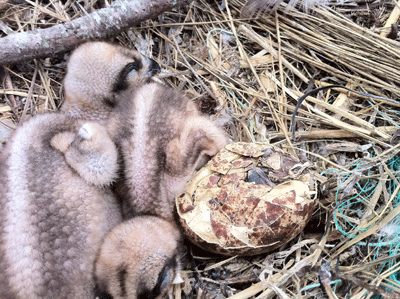 |
Back in May, we tried to
trap the adult male here, but were unsuccessful
(almost nothing went right on that trip). We
did, however, catch the female and in the
process discovered that she is a 15 year old
bird banded as a nestling over on the Westport
River on the SE Massachusetts coast back in 1996. In an
amazing coincidence, I was over on the Westport
River the very next day trapping Ospreys with
Alan Poole. We caught another female that
had been banded the same year in the same
colony. Their band numbers were 64 digits apart.
The picture here was taken on 26 May when we tried trapping the adult male. The two young were probably 2 and 4 days old at the time. They had a sibling that did not make it out of the egg. It was crushed somehow. This may have happened when the adults were coming or going from the nest, or perhaps a neighboring adult landed in the nest and there was a struggle. This does happen as can be seen in this amazing video of a male Osprey getting cold-conked when he happened to be in the middle of a fight between 2 females. I took him about 4 minutes to regain consciousness! |
Katama Bay -
"Snowy" |
17 July - We caught this
bird my "old-fashioned" way, with a noose carpet
after the young had fledged. I prefer tagging
young this way because I know the birds are full
grown and fairly muscled up, so fitting the
harness is not so much of a guessing game as it
is with pre-fledglings. We arrived around 8AM and found an empty nest. We put two bunker, or menhaden--a favorite on the Osprey menu--in the nest with the noose carpet over them. About 40 minutes later we saw a youngster fly over the nest. We followed his flight until he landed with his sibling on a nearby chimney, which we hadn't noticed. 10 minutes later, one of the young landed on the nest. Not infrequently, when trying to trap one of the young we wind up catching one of the adults--usually the female. In this case, Snowy was on the carpet, but hadn't yet gotten his feet tangled in the nooses, when his mother alit on the carpet. She was caught right away. We waited a bit to make sure the young was caught, and once we saw that the young was in the carpet, I went up and extracted the two birds from the trap. |
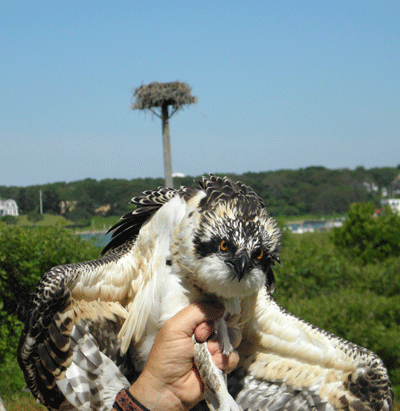 |
Snowy's piercing orange stare lets it be
known that he is none too pleased with this
whole operation. When I let him go, he flew
right back up to the nest and settled down as if
nothing had happened. Snowy's name comes from the location of his nest--at Snow Point on Katama Bay. |
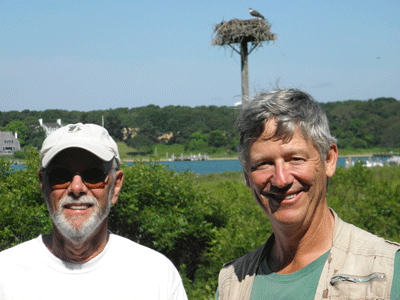 |
Dick Jennings and I after another successful trapping expedition. Snowy (standing in the nest behind us) is the 35th juvenile that we have tagged since starting this part of our research back in 2004. |
|
1 May 2011.
After the disastrous fall of 2010, we had a
pleasantly quiet winter and a safe return of all
our adults to their breeding grounds. After the
males got home, our one bird from the class of
'09, Buck, made his first return to the U.S.
after 18 months down in Venezuela. He took a
rather unconventional route and has yet to find
his way back to his 'hood down in South
Carolina. His travels from Virginia to New
Hampshire and back and again and back again are
truly remarkable. Last fall, the adult males all settled into remarkably small winter ranges (some not much more than a mile across). Our two youngsters, Belle and Thatch, are doing the typical teenage-Osprey thing--they find a spot, stay there for a while, and then go out on a road trip to look for greener (fishier) pastures. The adults are on a tighter schedule, and I was surprised that only one was on the move as of 22 March. North Fork Bob left his spot in Venezuela on the 20th, and just 4 days later Sanford left the Bahamas and Senhor Bones left his mountain hideout both on 24 March. Bones and Bob got past all the dangers of the Caribbean and made their way up the east coast back to their nesting territories. Sanford gave us a bit of a scare when he was blown off the coast of Georgia by a nasty weather front. Fortunately, he was able to fight his way back to the coast and settled down to wait it out in Savannah. A week later he was back on the Westport River. Each bird's target destination (their nests) is indicated on the map, color coded to that bird's track. |
 |
Birds of Prey page -- Osprey main page -- Migration page -- Home Page